The Manufacturer’s Ultimate Guide
to Trade Show Marketing
Standing Out at a Trade Show
Walk around any trade show and you will you see the same thing...
- endless booths with backdrops,
- video screens of all sizes,
- some overzealous sales and marketing people, and
- an entire catalog of promotional products.
Most companies ‘fit in’ to the trade show model. To make the most out of your massive investment, you need to do your best to stand out instead.
First, and Most Important, Be Prepared and Willing to Leave Your Comfort Zone
At a trade show, everyone is competing for attention. The booths that get most of the attention are the ones making a scene.
Be prepared to do what’s necessary to stand out. This can be REALLY hard for old-school business people. Can you picture yourself or your CEO throwing a branded stress ball at someone passing by your booth? If not, make sure you have someone there that is willing to do the dirty work.
Bottom line, you need to be willing to leave your comfort zone and stand out.
Stand Out Before the Trade Show Starts
A winning trade show strategy includes pre-show buzz for your booth. The challenge is that many other companies are also pre-promoting their booth. That means you need to STAND OUT with yours.
As a manufacturer, you’re in a slightly better position to stand out on social media because many manufacturers have barely even opened an account on Twitter for their company.
Jump to our: Maximizing Traffic at a Trade Show section for more on exactly what to do pre-show.
Stand Out During the Trade Show
While throwing stress balls at passers by may not be the best option for getting attention at trade shows, there are a multitude of other steps you can take to become a magnet.
Are you giving away a Hawaiian vacation? Then have a Hawaiian theme for your booth! I can already hear you saying, “But we’re a plastics manufacturer! What does a Hawaiian theme have to do with Plastics?”
It’s time to leave your comfort zone. Dressing in hula skirts (yes, guys too), and coconut tops rather than the standard trade show uniform of a branded polo shirt and khakis will attract attention.
It doesn’t have to be Hawaiian. Are you focused on having the best on-time delivery rates in the industry? Use a time theme. Hang large, obnoxious clocks around your people’s necks and give away clocks as promotional products.
Whatever you do, ditch the standard wardrobe and boring setups.
Hire Outside Entertainment:
There are endless opportunities to spice up your booth and draw in attendees with entertainment. A few that are sure to be a draw to include:
- A Magician - Saw your attendees in half and email them a picture of themselves cut in two. You’ll get their email address (a lead!), you can share it on social channels, and call out the attendee on social as well!
If you’re not down for hacking people in half, a magician has plenty of other tricks up their sleeve (or in their hat) to draw people to your booth. You just have to plan a way to transition them into conversations. - A Comedian - I bet you can get them to throw stress balls at people! Everyone likes to laugh. Use a comedian to draw in attendees.
- A Masseuse - Walking all day can be grueling. Carrying around your attendee bag can wreak havoc on your muscles. Hire a masseuse to work out the kinks.
- An Industry Star - Is there an iconic engineer or innovator you can have at your booth? Keep in mind, this needs to be a well-known industry star.
- A Fortune Teller - Much like a comedian or magician, a fortune teller can be a lot of fun, and in exchange for a business card, you can email the attendee a secret part of their fortune.
- A Photo booth - People love photo booths! Add a bunch of company branded props to make them remember you. Have them share their photos on social for a chance to win something, and email them their photos after the trade show.
Have an Exclusive Party:
I first read this idea in the book, The Ultimate Sales Machine, by Chet Holmes. Chet shares a few tips that I think are brilliant.
- Make the Party Exclusive - Exclusivity is key to driving demand for a company-sponsored party at a trade show. Spread the word on social media and by telling attendees. If they visit your booth, they can get a ticket into the party.
- Pick a HOT Venue - If there’s a brewery, night club, or other area attraction that you can book, do it. These are places that many attendees want to go to anyways. You’re making it easier for them. Whatever you do, don’t pick a dive bar…
- Pre-Negotiate a Per-Drink Price - Well ahead of the trade show and your party, contact the venues you’re considering. Let them know you’d like to bring in 100 of your closest friends for a party on a weeknight when the venue is usually slow. They will be drooling for the chance to get you in the door.
Insist that your party attendees don’t wait in line to get in and they don’t pay a cover charge at the door. They should be treated like VIPs. Then, arrange a per-drink cost that excludes water and soda. Give all attendees 2 chips for drinks that are only needed for alcohol. - Don’t Compete with Trade Show or an 800 lbs Gorilla’s Party - There’s almost always a trade show sponsored party. Don’t book your’s for the same night. You’ll regret it. The same applies to any 800 lbs Gorillas in the industry. You don’t want to compete with GE’s party!
You can however, piggyback on those parties if it’s possible. Have attendees migrate to your party after the other party. This one is a bit riskier and will take a bit more leggwork to make happen, but it’s not impossible.
You have to remember to stand out at the party. Your staff should be walking around asking if everyone’s having fun, and starting conversations. If not, your attendees simply drank and partied on your dime.
Everyone gives away shirts, stress balls, thumb drives, and folders. To stand out, give away something unusual. How about that branded clock on a necklace I mentioned above to signify your dedication to on-time delivery? Here’re a few others:
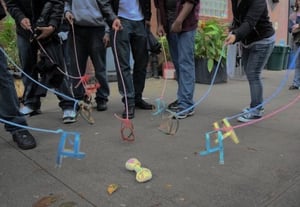 A branded backpack to carry all of their swag.
A branded backpack to carry all of their swag.- Kids toys for all those parents that promised to bring their child back something.
- An invisible dog on a leash.
- Chia Pets.
- Hangover recovery tool kits.
Stand Out After the Trade Show
If you took advantage of some (or all) of the ideas above, you may owe some attendees follow up emails. Did you take pictures you promised to send? Did you have a good conversation that you want to pick back up? Either way, follow up will be important. There’s a whole section in this guide on making that happen!
Here’s a few ways to stand out after the trade show:
- Use Humor While Being Human - Everyone feels like they were hit by a train by the time they get home from a trade show. Make sure your follow-up emails and outreach use humor to stand out. For example:
- Send an email with a funny subject line - “Enclosed - Recovering from [Name of Trade Show] for Dummies”
- Send all attendees an email with some of the funny photos you took at the trade show
- Announce the Winners of a Trade Show Contest - Keep attendees engaged after the show by announcing contest winners the week after. It will help if the prize is a big one!
- Set the Stage for Next Year or Next Show - If you really have your stuff together, announce the big giveaway for next year’s trade show or the next one you’re attending
Yeah… But All of Those Things Cost Money
Yes, you will need to invest in materials for a theme. Yes, entertainment will cost money. Yes, that Hawaiian vacation will be expensive.
How do those expenses compare to the lifetime value of a new customer? As a manufacturer, they are probably a drop in the bucket.
If standing out at 4 trade shows per year will be too big of an investment, what if you pick the top 3 and knock them out of the park?
Blend In and Take the Scraps, or Stand Out and Take the Prime Cuts
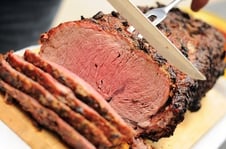 You’re already investing a lot of resources into a trade show, so shouldn’t you be looking to maximize conversations, connections, and leads?
You’re already investing a lot of resources into a trade show, so shouldn’t you be looking to maximize conversations, connections, and leads?
To get the most booth traffic, you need to stand out. That might mean leaving your comfort zone.
How to Maximize Traffic at a Trade Show

Trade shows are all about maximizing numbers. The number of people you can interact with. The number of business cards you can collect. The number of quality conversations you can have.
It's VITAL to draw in as much traffic to your booth as possible.
Let’s Get on the Trade Show Radar
Maximizing visitors at a trade show requires 2 buzz-generating efforts:
- Outreach before the tradeshow (months before, maybe even a year before),
- Standing out during the show (remember our previous tips? Now’s your time to shine!)
Creating a Buzz Before the Show
Consider this your homework before the trade show. Let’s get people thinking early about it. They should see enough of you, your name, and your brand in the weeks and months before to become synonymous with the show.
Social Media
Social media will obviously play a key role before, during, and after your trade show. You’ll want to use the trade show hashtags (e.g., #fabtech18, #ipcapexepo) when you’re sharing information about your attendance there.
-
Know your booth number? Announce it loud and proud. (Helpful hint: A floor layout saying “We are here!” is incredibly helpful to highlight your little corner of the tradeshow galaxy.)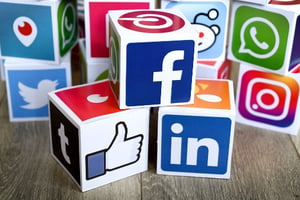
- Have an update on the development of a product for display? Tease your followers with drawings, pictures, and videos of various stages of production.
- Research and use the appropriate hashtag for the event (Ex. - #FabTech18, #InfoFlex, etc.) to be heard in the digital conversation.
- Follow industry thought leaders. They may be inclined to follow you back. Share their content. They may be inclined to share yours in return.
- Publish a poll on social media. A yes or no question like “Are you planning on attending [trade show]?” gets your buyer persona thinking about the show and your place in it. (Oh yeah, you’ve also identified potential visitors to target.)
- Announce a promotional contest. Bring hordes of visitors to your booth to enter a promotional code or whatever they need to cash in on their winnings (in person). Make sure it’s an actual prize - no T-shirt or swag bag they could get at any of the hundreds of other booths at the show.
- Use humor, HEAVILY… Trade shows are often viewed as a work party, like it or not. You want attendees to feel like visiting your booth will be fun.
If you're looking for more specific social media tips to promote your upcoming manufacturing trade show, check out this blog here.
Email Engagement
Here’s your chance to engage current and former clients as well as any other contacts you may have in your CRM. Strategically plan a series of email blasts announcing your company’s presence at the trade show.
Many of the social media tactics listed above can be repurposed in your email campaign. But email gives you the added advantage of nurturing a longer, more in-depth conversation.
Many manufacturers are best served to begin hitting the email strategy hard 6-8 weeks before the show, when attendees are finalizing their itinerary, travel, and accommodations.
Here are some example email workflow topics:
- Announce your booth number. You’ll initiate the conversation by indicating where you’ll be when you’ll be there and softly expressing wishes to touch base. If possible, do some of the heavy lifting for your contacts and provide a link to register for the show. Some trade shows even offer a limited number of free passes for companies to give out for promotional purposes.
- Unveil your product. Or better yet, unveil only a part of it. Give them a reason to show up at your booth and see the finished product in all its glory. (Don’t forget to include your booth number again.)
- Educate about new industry insights and trends. Let folks know you’re on top of the day-to-day happenings and evolutions in your industry. If there’s a new hot topic, note how your product fits within the picture. (Did we mention the booth number?)
- Introduce your trade show team. Give them a friendly face or faces to seek in the crowd. Provide a brief bio of each team member who’ll be in attendance. Build trust around their years of experience and areas of expertise. Personalize their stories and make them relatable. People are more comfortable speaking with a “mother of 2 beautiful children” than a sales drone. (Cough - booth number - cough.)
Each email should contain a clear call to action - an opportunity for recipients to click, raise their hands, and identify themselves as interested. This CTA could be to schedule an appointment at the show, or just RSVP that they will visit your booth.
Organize these emails sensibly. The last thing you need heading into the main event is to annoy and alienate your contact database with spam. Spread out the emails over time so you’re welcomed warmly into their inboxes - and NOT flagged as spam or unsubscribed from.
And if it’s a regional trade show, segment your contact database, if possible, to reach only those likely attendees. Unless it’s a major national or international conference, an email recipient in Seattle would likely have little use for info about a show in Miami.
Buzzworthy Blogging
Your company’s blog is another avenue to discuss what makes this trade show so great. The best fairs often include educational forums, seminars, and keynote speakers.
Which educational sessions will be the most beneficial for you and your company? Chances are they’ll also be beneficial for your prospects. Blog about what you intend to learn from those sessions and how your company plans to implement it.
Blogging can be a team effort. Assign a week for each member of your team to blog about their trade show hopes.
And here’s the great thing about blogs: They’re proprietary pieces of content you can plaster all over social media and include strategically in your email nurturing campaign. When sharing on social media, be sure to @-mention the event and speaker. They’ll appreciate the free publicity and share your post with their followers.
Shining Like a Brass Penny at the Show
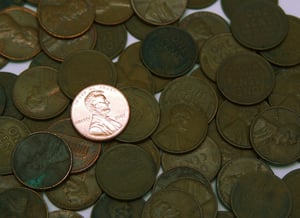 The big day arrives and now’s your time to shine. So much of your success here relies upon following through on your promises made leading up to it.
The big day arrives and now’s your time to shine. So much of your success here relies upon following through on your promises made leading up to it.
- Is your product ready to display?
- Is your show staff briefed on all its bells and whistles (and prepared to schmooze each passerby about why they can’t live without it)?
- Do you actually have that amazing promotional giveaway?
Many trade show efforts fall short because of poor planning and engagement. If you agreed to meet with a contact at your booth at a certain time, well, duh, be there.
Get on the Trade Show Radar and Maximize Visitors to Your Booth
You invest a small fortune in trade shows, so maximizing traffic to your booth has to be a top priority. Trillions of dollars in business deals are sealed at such shows every year. It all starts with maximizing the numbers.
How to Maximize Leads at a Trade Show

Some company leaders feel attending trade shows is a waste of time these days. If you don’t bother preparing to capture customers efficiently and with next steps in mind, that’s probably true.
The Center for Exhibition Industry Research found that 80% of trade show attendees are looking for new products. That means they could be looking for you.
So, how do you increase your odds of making an interaction last beyond a quick “hello”?
1. Reinvigorate Past Customers
Reach out to customers who you haven’t worked with recently and who might not know what you’re up to. Turn those past customers into hot leads!
You can set up times to meet these people in person and get that valuable face-to-face time. They already know (most of) your capabilities, so they should be easier to sell.
2. Have a Form Ready
Another sign trade shows are becoming a little too old-school: 59% of companies are still using paper-based lead forms and business cards to collect information from attendees.
This works fine if your people are meticulous about collecting and organizing this data, but it requires a lot of tedious, manual work. There’s also the possibility of losing forms and especially those tiny business cards.
As a time-saving alternative, you can have a tablet or laptop on hand to log prospects into your CRM immediately. Make the form simple and quick.
Just these will do:
- First and last name
- Company email address
- Industry
Unlike the old way of collecting business cards, you don't need to pay someone to enter them in your customer relationship management (CRM) system. You also don't have to worry about forgetting or procrastinating on data entry until it's too late to capture those customers. By using a tablet, their info will go right into your CRM.
3. Provide FREE Educational Resources
Want to get the booth visitors to enter their own information into your CRM? Offer a super-informative, educational e-book or other resources in exchange! Don’t forget to emphasize it’s free.
Most people go to a trade show to learn about products and services, but they also want to be educated about their everyday pain points. That's how you offer more than your competitors!
Beyond the initial gratification of scoring something free, your leads should also receive motivation to continue along the buyer’s journey. So make sure your resource has follow-up content to capitalize on this awesome momentum.
Following Up with Trade Show Leads
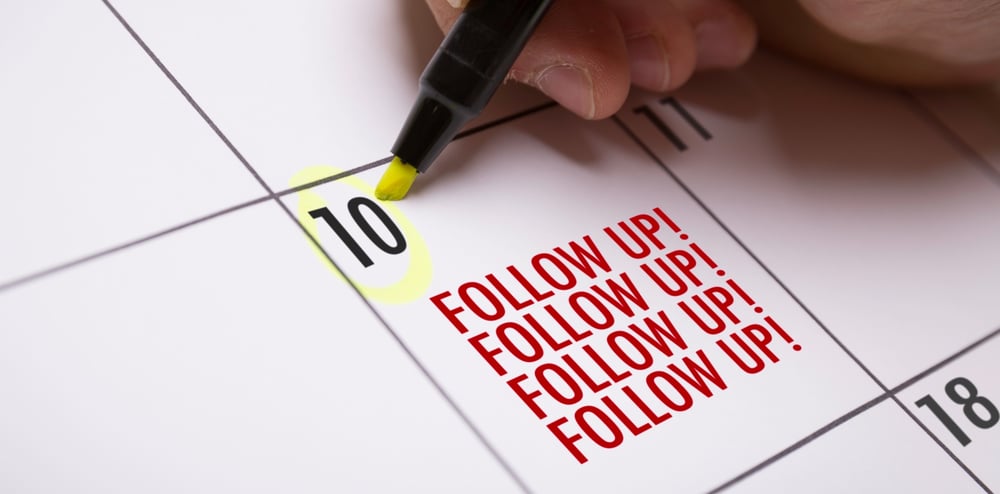
All trade show leads are not created equal...at least in the mind of a sales person.
Here’s where the problem arises: the hot leads get all of the attention and in most cases priority on the follow up list. And by priority, we mean that every other lead will fall through the cracks.
I’m not saying that you shouldn’t prioritize what you think are the hot leads over the cold leads... but I am saying not to forget about the cold leads.
You should follow up with every trade show lead because gauging the quality of a lead from only a simple conversation at the show is based on assumption only. And you know what they say happens when you assume ;).
Think about it. The people you meet are bombarded with conversations from all of the other exhibitors ALL DAY LONG. They don’t have time for everyone and lack of interest at the event could just be that they’re worn out.
Additionally, someone that seems hot might only be entertaining you to get some free swag.
Bottom line...don’t assume, follow up with everyone to make sure you’re getting the biggest bang for your buck!
Follow Up Timing
Be sure that your initial follow up from the show is prompt. It doesn’t have to be the same day, but waiting too long will allow momentum to fade and conversations to be forgotten. Consider something as simple as:
Hi <name>,
It was nice meeting you at <tradeshow name> the other day.
I’m sure you're busy after being gone for the show, so I’ll reach out next week after you’re able to get caught up and we can take it from there.
Thank you,
<name>
This is something you can have prepared in advance and gives you some breathing room. The prompt follow up will not only set you apart from the competition, but allows this simple touchpoint to get lost in the shuffle, not your more meaningful messages.
Follow Up Frequency
Don’t stop at just one email, especially if you are promising that you’ll follow up with them the following week. Plan out a follow up series of touchpoint emails that continually provide some sort of value to them.
In the short term you should consider at least a few emails within the first couple of weeks, but also plan out a longer term follow up to stay on their radar if they aren’t quite ready to buy.
Depending on your industry and your business, a trade show lead might become a customer in a week, a month, 6 months, or even years. Your long term touchpoint strategy should be in line with your sales cycle.
While frequency is important, don’t be annoying. This doesn’t really need further explanation... just use your best judgement.
Follow Up Customization
Most of the follow up messages attendees will receive will be generic, out-of-the-box, useless information begging for their business.
Set yourself apart by personalizing your follow up to the prospects and provide value. Here are a few ways you can tailor your messages:
- Speak to conversation points at the show
- Use rapport builders
- Research their company and provide tips
- Mention a recent blog post on their website
- Mention company news
- Ask them a question specific to their business
- Share an article that would be valuable to them
- If you really want to excel, take a selfie with them at the show and include it in one of your follow ups
Obviously you won’t have enough time in your day to customize every message to every person you talked to at the show. In this case you can segment and spend more time on the people that are more likely to buy and less time on the people that are less likely to buy.
Use Technology
Like me, you’re a human. As a human, we tend to let things slip...including follow up. This is where technology can be your friend.
Automating Follow Up
HubSpot has a great tool called sequences in which you can queue up a series of emails, each with varying levels of customizations. You can determine how long to wait before your follow up emails go out. The best part is, if your lead responds to the message the sequence stops so they don’t feel like they’re talking to a robot.
If you don’t have awesome automation tools like that, at the very least use your CRM to create follow up tasks for your follow up steps. Without these tasks or calendar reminders, your follow up will be sloppy and highly ineffective.
Leverage Social Media
This is probably a given, but connect to your leads on social media, especially LinkedIn. Now for the hard part...don’t JUST find the name and click connect and let it go. CUSTOMIZE your connection message. You’re trying to set yourself apart from everyone else and everyone else is NOT sending a customized message.
Pick Up the Phone
It’s a digital world, but a simple phone call can go a long way. Like your emails, these phone calls should not be generic.
You’re not calling them to ask them for RFQs, you're calling them to have a conversation and keep the relationship going. Build rapport, provide value, and have a short conversation.
If after the conversation it makes sense to schedule a follow up, do so but don’t go into it expecting a close.
Using a CRM to Make the Most of Your Trade Show
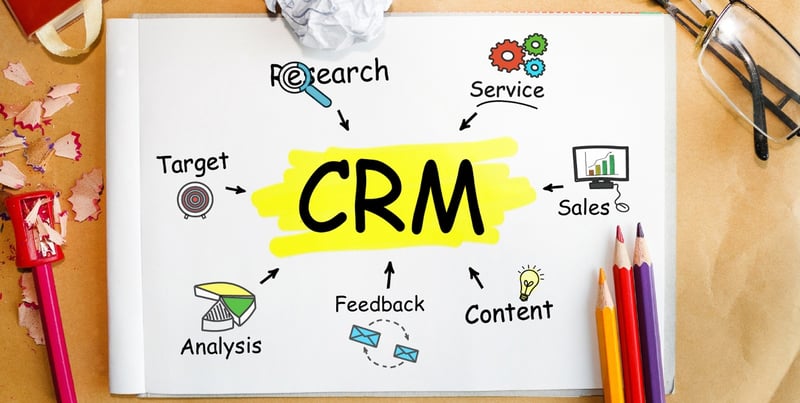
In all likelihood you are exhibiting or attending a tradeshow to collect leads. The hope is that eventually those leads will turn into actual customers, but it won’t happen overnight.
Every prospect, lead, or person with a pulse that you interact with at a tradeshow should be stored in your CRM.
If you don't already use a CRM, not to worry, there are many great options out there (keep reading for a list) and the financial investment starts at free...so hop on it. And no, an Excel spreadsheet doesn’t count.
Important CRM Guidelines to Follow:
- Record all vital information, which will include information that nearly every business card in the world will contain:
- Name
- Phone
- Company
- Title
When you collect a business card, make some quick notes on the card that you can store later (details of conversation, rapport notes). - Make sure that the leads are identified as being collected from the tradeshow. This will not only help to track return-on-investment (ROI), but also help with lead nurturing and follow up.
- Record any specific notes that are unique to a contact. You should store this and associate it with the contact, not a company. You should store the context of your conversation so that you can reference it in your follow up.
- If you want to be really good, store any rapport building items you may have collected:
- Hometown
- College
- Kids or family info
- Favorite sports teams
- Pain points you discussed
- Etc.
- Record information in the CRM as quickly as possible. It’s not likely that you will do it on the spot, but if you have downtime in the evening or on your return travel, that is best. At the very latest, enter your fresh new contacts into the CRM the first day you return to the office.
The sooner you enter this information, the more you’ll remember about the conversation. Also, there’s less of a chance the information you collected will get lost in the shuffle of your life. - Everyone in your business should be using the same CRM. A CRM is only as good as the data that’s in it. If one sales person decides they just want to use Excel, there’s potential for overlapping communication an inaccurate information.
CRM Systems for Manufacturers
If there's one word we stress to manufacturers that are diving into their first CRM, it's SIMPLICITY.
At some point you might need all the bells and whistles and customizations of huge CRM platforms. Right now, you need an intuitive platform that everyone can learn to use, out of the box.
When your team is proficient and needs a higher level of tools, go more advanced.
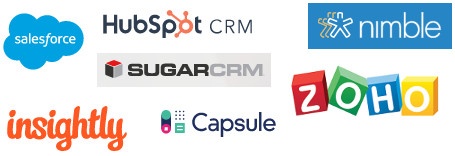 HubSpot CRM + Sales Pro (our favorite)
HubSpot CRM + Sales Pro (our favorite)- HubSpot CRM Free
- Capsule
- SugarCRM
- Insightly
- Zoho
- Nimble
- SalesForce
3 Additional Tools for Trade Show Marketing
Despite the popularity of trade shows, many manufacturers aren’t using them to their full advantage when in comes to lead generation.
There are several tools to help you take complete advantage of your trade show attendance:
1. Lead Flows
A lead flow is essentially a pop-up form. All HubSpot marketing software users now have access to lead flows, so if you don’t have a HubSpot free account set one up.
You may be asking yourself, how is a lead flow going to help during a trade show. Well, it won’t help you during, but it can help you before. Setting up a pop-up box, also known as an overlay, can help you schedule appointments with website visitors during the trade show. There aren’t many things better than face-to-face time with a client or prospect.
Lead flows can also be connected to nurturing efforts, so you can automate emails to remind your website visitors of your appointment. Time is money at a trade show.
Side note: If you’re already using MailChimp, they recently introduced lead flows to their tool set.
2. Landing Page With A Form
Let’s think about a scenario for a second. You just met several hundred, maybe even thousand potential customers at the manufacturing trade show. They know your name, and they know your company’s name, so they go to the homepage of your website and look around for a few seconds....
...and you’ve lost them.
They're on to the next vendor's site.
Don’t Miss Potential Conversion Opportunities
If you’ve ever been an exhibitor at a trade show before, you know just how valuable the traffic to your booth can be.
Here are some statistics (for more proof):
- 46% of executive decision makers made purchase decisions while attending a show
- 51% of trade show attendees requested that a sales representative visit their company after the show
- 92% of trade show attendees come to see and learn about what’s new in products and services
Using a landing page, you can captures a visitor’s contact info through a form. Your landing page should target your trade show audience specifically and provide value. Do you have any educational content that would be of value to a potential prospect? Or capabilities information?
The educational content combined with a form/landing page will let the website visitor/trade show attendee re-introduce themselves through your site. This will let you connect the dots and see who was really listening at the show.
Don’t miss out on potential conversion opportunities by not creating a landing page.
3. Email Marketing Platforms
How many times have you gotten back from a trade show with a stack of business cards or a list of contacts a mile long or leads from your landing page? Yeah...generating leads never seems to be the problem. But, finding the time to follow up with them IS.
Marketing automation can help. Platforms such as HubSpot and MailChimp are great tools, but they can’t do the work for you. You still have to create the emails, you just don’t have to remember to send them when the time comes.
Here are 3 steps to create an effective email drip campaign:
- Define the goal of your email campaign - If you don’t know what you want to accomplish with your campaign, it’ll be really hard to actually achieve it.
- Your content matters - Make sure your emails are adding value. No one wants to be bothered with several emails that mean absolutely nothing to them.
- Make your lead’s decision-making process easy - When you start working on creating content for your campaign, ask yourself “what do my prospects need to know in order to take the step I want?”
So, if your goal is to sell your leads something, you should aim to increase their trust in you. You can do this by teaching them something useful, addressing their hesitation (removing friction), and providing proof of how your product or service helps them achieve their goals.
Calculating the ROI of Your Trade Show
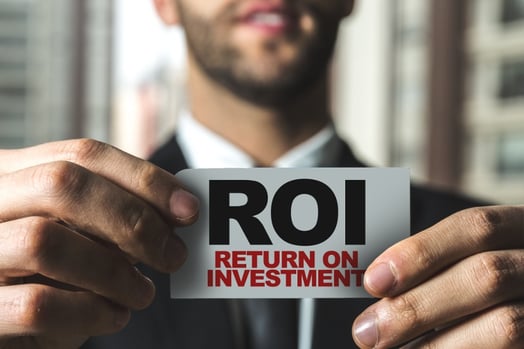 At the end of the day, the reason you, as a manufacturer, are willing to invest so many financial and human resources into trade shows is because you think you’ll be able to produce a positive return on that investment.
At the end of the day, the reason you, as a manufacturer, are willing to invest so many financial and human resources into trade shows is because you think you’ll be able to produce a positive return on that investment.
If you didn’t, you surely wouldn’t bother.
Calculating Your Trade Show ROI
The formula for calculating your trade show ROI is:
(Gross Profit - Total Trade Show Expenses) / Total Trade Show Expense
It’s really important to be as accurate with these numbers as possible. Let’s start by clarifying these values to make sure you’re calculating an accurate ROI value.
Gross Profit From Trade Show: this number should include only profit from sales produced because of this specific trade show. Meaning, these sales should be from leads created at the trade show, or prospects that closed as a result of your attendance at the trade show. Including any other sales will skew your ROI number.
Total Trade Show Expenses: this number should include all costs associated with the trade show, including
- booth design, components, and materials (if you’ve used the same for multiple shows, divide the cost),
- pre-and post-show promotion,
- travel, lodging, food, and entertainment expenses,
- trade show fees,
- parties or other promotional events,
- and the cost of your team’s trade show time before, during, and after the trade show.
Long Sales Cycles Mean a Delayed ROI Calculation
Like most manufacturers, you probably have a long sales cycle. This means calculating a true ROI may take a little while. Be patient.
It’s really important that this exercise doesn’t slip off your radar. You don’t want to invest all those financial and personnel resources into activities that aren’t producing a positive ROI.
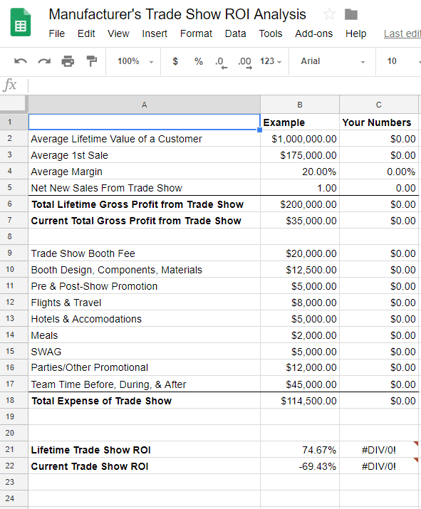 A Trade Show ROI Spreadsheet
A Trade Show ROI Spreadsheet
To make calculating your trade show ROI easier, we’ve put together the following spreadsheet:
https://docs.google.com/spreadsheets/d/1_aePHkwDNBE9DtOtJt8Tc3lI7LFe7qcaSIjQk0SusMs/edit#gid=0
To enter your own values in the spreadsheet, you'll need to make a copy of your own by
- Selecting 'File'
- Selecting 'Make a Copy'
- Choosing where to save it
- Clicking 'OK'.
If you don't use Google Sheets, you can also download an Excel version by
- Selecting 'File'
- Selecting 'Download as'
- Choosing the desired file type
- Setting any available options (e.g., page orientation)
- Clicking 'Export'.
Make the Most Out of Your Trade Show Time and Money
We know you don't need us to tell you that trade shows are important. By using these tips to maximize your traffic and leads while spreading the word about your business and products, trade shows just might become one of the most important (and fun!) elements of your marketing.
Planning is Everything! But...
Maybe we can help? Use the form to the right to chat with one of our experts!


